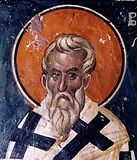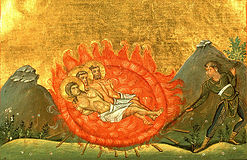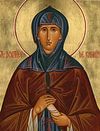

| Previous day | Next day |
| Old Style
February 6
|
Wednesday |
New Style
February 19
|
|
Tone 2.
Fast Day. |
Fish, wine and oil allowed.
|
![]() St. Bucolus, bishop of Smyrna (ca. 100).
St. Bucolus, bishop of Smyrna (ca. 100).
Virgin-martyr Dorothea, and with her Martyrs Christina and Callista, sisters, and Theophilus, at Caesarea in Cappadocia (288-300). Virgin-martyr Fausta, and with her Martyrs Evilasius and Maximus, at Cyzicus (305-311). Martyr Julian of Emesa (312). Sts. Barsanuphius the Great and John the Prophet, monks of Gaza (6th c.). St. Photius, patriarch of Constantinople (891). Virgin-martyrs Martha and Mary and their brother Lycarion at Tanis (Hermopolis) in Egypt. St. Dorothea, schemanun, of Kashin (1629).
New Hieromartyr Dimitry Rozhdestvensky, archpriest, of Verny, and his son New Martyr Anatole (1922). New Hieromartyr Basil Nadezhnin, priest, of Moscow (1930).
St. James, ascetic, of Syria (ca. 460). St. Mael, bishop of Ardagh (488), disciple of St. Patrick. St. Vedast, bishop of Arras (540). St. John of Thebes, monk of Palestine (6th c.) St. Amand, apostle of Maastricht (675). St. Arsenius of Iqalto, Georgia (1127).
Repose of Archbishop Theophan (Bystrov) of Poltava (1940).
Thoughts for Each Day of the Year
According to the Daily Church Readings from the Word of God
By St. Theophan the Recluse

Wednesday. [I John 3:21–4:6; Mark 14:43–15:1]
If help is needed, ask. “I asked,” you say, “and it was not given.” But then how is it given to others? With the Lord there is no respect of persons; to give to one, and not to give to another without any reason. He is ready to give to all—for He loves to be giving. If He does not give to someone, the reason is not in Him, but in the one asking help. Among such reasons can be some that we cannot even guess. But there exist known reasons, visible to anyone. One of these reasons (and is it not the chief reason?) Saint John points out to be the absence of confidence, and the absence of confidence comes from the condemnation of the heart or the conscience. Beloved, he says, if our heart condemn us not, then have we confidence toward God. And whatsoever we ask, we receive of Him, because we keep His commandments, and do those things that are pleasing in His sight (I John 3:21). There is nothing more to add to these words. Everything is clear in and of itself. What master will help an unfaithful servant, a squanderer and profligate? Will the Lord really indulge us when we do not want to please Him and fulfil His commandments; if we only start praying when an extreme need arises?!
Articles
 St. Bucolus the Bishop of SmyrnaSaint Bucolus, Bishop of Smyrna, was a disciple of the holy Apostle and Evangelist John the Theologian, and became the first Bishop of Smyrna (Asia Minor). |
 Virginmarty Fausta at CyzicusThe girl bravely confessed her faith and was subjected to many cruel tortures. |
 Martyr Evilasius at CyzicusSaint Evilasius was an eighty-year-old pagan priest who was ordered to turn Saint Fausta away from Christ. |
 Martyr Maximus at CyzicusThe eparch Maximus was sent to investigate the case of Saints Fausta and Evilasius for the emperor, and he began to torture the old man who had come to believe in Christ. |
 Martyr Julian of EmesaHe was a skilled physician, and healed illnesses not only of the body but also of the soul, and he converted many people to faith in Christ the Savior. |
 Venerable John the ProphetSaint John, a disciple of Saint Barsanuphius, lived in a cell outside the monastery of Abba Seridus for eighteen years until his death. |
 St. Arsenius of Iqalto in GeorgiaSaint Arsen of Iqalto was a translator, researcher, compiler of manuscripts, hymnographer, philosopher, and a great defender of the Georgian Christian Faith. |









